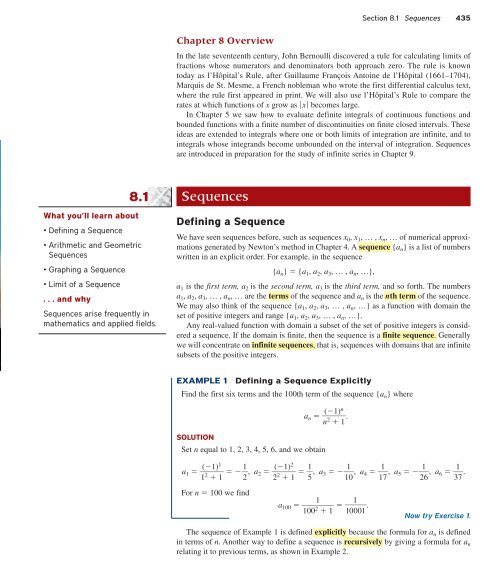Create successful ePaper yourself
Turn your PDF publications into a flip-book with our unique Google optimized e-Paper software.
Chapter 8 Overview<br />
Section 8.1 Sequences 435<br />
In the late seventeenth century, John Bernoulli discovered a rule for calculating limits of<br />
fractions whose numerators and denominators both approach zero. The rule is known<br />
today as l’Hôpital’s Rule, after Guillaume François Antoine de l’Hôpital (1661–1704),<br />
Marquis de St. Mesme, a French nobleman who wrote the first differential calculus text,<br />
where the rule first appeared in print. We will also use l’Hôpital’s Rule to compare the<br />
rates at which functions of x grow as x becomes large.<br />
In Chapter 5 we saw how to evaluate definite integrals of continuous functions and<br />
bounded functions with a finite number of discontinuities on finite closed intervals. These<br />
ideas are extended to integrals where one or both limits of integration are infinite, and to<br />
integrals whose integrands become unbounded on the interval of integration. Sequences<br />
are introduced in preparation for the study of infinite series in Chapter 9.<br />
8.1<br />
What you’ll learn about<br />
• Defining a Sequence<br />
• Arithmetic and Geometric<br />
Sequences<br />
• Graphing a Sequence<br />
• Limit of a Sequence<br />
. . . and why<br />
Sequences arise frequently in<br />
mathematics and applied fields.<br />
Sequences<br />
Defining a Sequence<br />
We have seen sequences before, such as sequences x 0 , x 1 , … , x n , … of numerical approximations<br />
generated by Newton’s method in Chapter 4. A sequence {a n } is a list of numbers<br />
written in an explicit order. For example, in the sequence<br />
{a n } {a 1 , a 2 , a 3 , … , a n , …},<br />
a 1 is the first term, a 2 is the second term, a 3 is the third term, and so forth. The numbers<br />
a 1 , a 2 , a 3 , … , a n , … are the terms of the sequence and a n is the nth term of the sequence.<br />
We may also think of the sequence {a 1 , a 2 , a 3 , … , a n , …} as a function with domain the<br />
set of positive integers and range {a 1 , a 2 , a 3 , … , a n , …}.<br />
Any real-valued function with domain a subset of the set of positive integers is considered<br />
a sequence. If the domain is finite, then the sequence is a finite sequence. Generally<br />
we will concentrate on infinite sequences, that is, sequences with domains that are infinite<br />
subsets of the positive integers.<br />
EXAMPLE 1<br />
Defining a Sequence Explicitly<br />
Find the first six terms and the 100th term of the sequence {a n } where<br />
SOLUTION<br />
Set n equal to 1, 2, 3, 4, 5, 6, and we obtain<br />
(1) a n n 2 .<br />
n<br />
1<br />
(1) a 1 1 2 1 1 1 2 , a (1) 2 2 2 2 1 1 5 , a 1 1 1 1<br />
3 , a 4 , a 5 , a 6 .<br />
1 0 1 7 2 6 3 7<br />
For n 100 we find<br />
1 1<br />
a 100 100<br />
2 .<br />
1 10 001<br />
Now try Exercise 1.<br />
The sequence of Example 1 is defined explicitly because the formula for a n is defined<br />
in terms of n. Another way to define a sequence is recursively by giving a formula for a n<br />
relating it to previous terms, as shown in Example 2.












